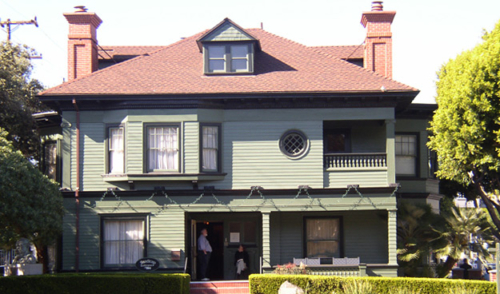First Roy Jones House

- Known As
- Queen Anne Victorian, American Colonial Revival
- Architect
- Sumner P. Hunt
- Built
- 1894
- Designated
- January 2, 1979
Architecture experts have disagreed on exactly how to classify the First Roy Jones House. Some see it as a simplified Queen Anne dwelling and note its Victorian details. These include bay windows and the use of ornamental woodwork (such as brackets under the eaves, and turned spindles supporting railings on both lower and upper-story porches). Others note the house’s American Colonial Revival elements. For example, the Roy Jones House features fluted Ionic columns decorating second-story corners, dormers on the roof, and a generally restrained style. For still other experts, the boxy form and horizontal emphasis of the residence, along with its hipped roof, are most suggestive of the American Foursquare style of building. Given these differences of opinion, the First Roy Jones House is perhaps best viewed as a transitional work, based on an original combination of styles, devised by its well-known architect.
The First Roy Jones House was designed by architect Sumner P. Hunt. Hunt came to the Los Angeles area in 1889 and was just beginning his long and productive career here when he conceived this home. Indeed, the Jones house is one of Hunt’s earliest surviving works. Over the course of a forty-year-long career Hunt would go on the complete many important commissions in Southern California, including schools, clubs, a hospital, and the Southwest Museum. Many of Hunt’s later buildings were executed in Mission and Spanish Colonial styles, making the First Roy Jones House an especially unusual example of his work.
The house, as its name implies, was built for Roy Jones and was originally located at 1007 Ocean Avenue. In the 1890s, Ocean Avenue was the most fashionable residential street in the small but growing town of Santa Monica. As such it was a natural choice for the Roy Jones dwelling. Roy Jones was the only son of Senator John P. Jones, the founder of Santa Monica. He was also a civic leader in his own right. Roy Jones worked on Santa Monica’s City Charter and was a pillar in the business community, as a founder and officer of the Bank of Santa Monica.
The Jones family owned this house on Ocean Avenue until 1903 when it was sold to Gustavus S. Homes. Homes lived in it until the mid-1930s. Later, the residence was converted into a rooming house and allowed to deteriorate. By 1976, the structure was slated for demolition. However, thanks to both public and private efforts, the building was saved and moved to its present location for use as a museum dedicated to California arts and culture—the California Heritage Museum. Because the museum is open to the public, visitors have the rare opportunity to see both the interior and exterior of this landmark structure.
Sources:
- David Gebhard and Robert Winter. Los Angeles: An Architectural Guide. Salt Lake City: Gibbs-Smith Publisher, 1994.
- Robin Guild. The Victorian House Book. New York: Rizzoli International Publications, 1989.
- Cyril M. Harris. American Architecture: An Illustrated Encyclopedia. New York: W.W. Norton, 1998.
- Santa Monica Historical Resources Inventory, 1985-1986. Vol. 1. City of Santa Monica, Building and Safety Department.
- Santa Monica Mirror, “Queen Anne House Continues to Reign,” March 5-11, 2003.
- Staff Report on 2612 Main Street, First Roy Jones House. City Planning Division, Santa Monica.
- Robert Winter, ed. Toward a Simpler Way of Life: The Arts and Crafts Architects of California. Berkeley: University of California Press, 1997. (Includes a chapter on Sumner P. Hunt)